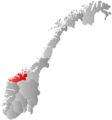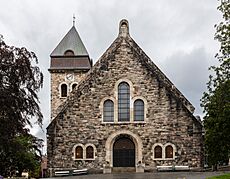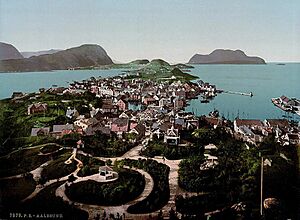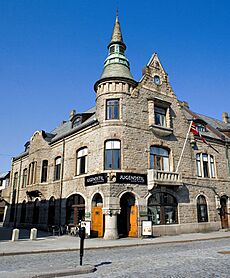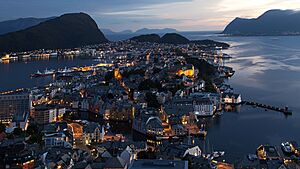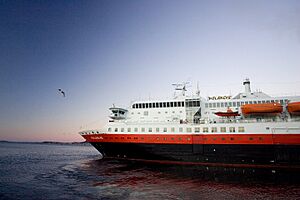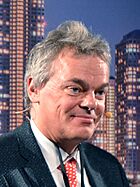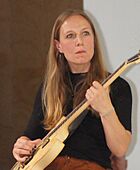Ålesund facts for kids
Quick facts for kids
Ålesund kommune
|
|||
|---|---|---|---|
|
Municipality
|
|||
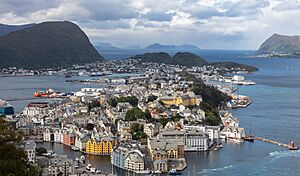
Part of town seen from Aksla viewpoint
|
|||
|
|||
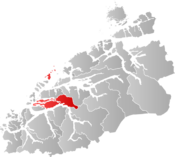
Ålesund within Møre og Romsdal
|
|||
| Country | Norway | ||
| County | Møre og Romsdal | ||
| District | Sunnmøre | ||
| Established | 1 January 1838 | ||
| Administrative centre | Ålesund | ||
| Area | |||
| • Total | 632.51 km2 (244.21 sq mi) | ||
| • Land | 607.41 km2 (234.52 sq mi) | ||
| • Water | 25.10 km2 (9.69 sq mi) 4% | ||
| Area rank | #184 in Norway | ||
| Population
(2023)
|
|||
| • Total | 67,250 | ||
| • Rank | #13 in Norway | ||
| • Density | 111.2/km2 (288/sq mi) | ||
| • Change (10 years) | 9.1% | ||
| Demonyms | Ålesundar Ålesunder |
||
| Time zone | UTC+01:00 (CET) | ||
| • Summer (DST) | UTC+02:00 (CEST) | ||
| ISO 3166 code | NO-1508 | ||
| Official language form | Neutral | ||
| Created as | Formannskapsdistrikt in 1838 | ||
|
|
|||
Ålesund is a beautiful town and municipality located in Møre og Romsdal County, Norway. It's part of the Sunnmøre region. The town of Ålesund is the main center for the municipality. It's a busy port town, famous for its unique Art Nouveau architecture. While its old spelling was Aalesund, the modern Norwegian spelling is Ålesund. However, the local football team, Aalesunds FK, still uses the older spelling.
Ålesund is the 184th largest municipality in Norway by size, covering about 633 square kilometers. It's also the 13th most populated, with about 67,250 people living there. The number of people living in Ålesund has grown by over 9% in the last 10 years!
Contents
About Ålesund
How Ålesund Grew
Ålesund started as a small port called Aalesund in 1793. It slowly grew and in 1848, it became an important market town. In 1838, it got its own local council, which meant people could make more decisions about their town.
Over the years, Ålesund grew by joining with parts of the nearby Borgund municipality. For example, in 1968, a large part of Borgund merged with Ålesund, making the town much bigger and doubling its population to about 38,589 people! Later, in 1977, the island of Sula became its own separate municipality.
More recently, in 2020, Ålesund became even larger when it merged with several other municipalities: Haram Municipality, Skodje Municipality, Sandøy Municipality, and Ørskog Municipality. However, in 2024, the northern part that used to be Haram separated again to form its own municipality.
What's in a Name?
The name Ålesund comes from the Old Norse words Álasund. The first part, ála, likely means "eel", and the second part, sund, means "strait" or "sound". So, it might mean "eel strait". Before 1917, the name was spelled Aalesund, but then it changed to Ålesund with the letter Å.
Ålesund's Coat of Arms
The coat of arms for Ålesund was created in 1898. It shows a red background with a fishing boat on the water and three cod fish below it. The boat and fish are silver or white. Above the shield, there's a special crown. This design shows how important fishing has always been to Ålesund. The boat is like those used in the 1700s and 1800s.
Churches in Ålesund
The Church of Norway has several parishes, or local church areas, in Ålesund. The main church is Ålesund Church.
| Parish (sokn) | Church name | Location of the church | Year built |
|---|---|---|---|
| Borgund | Borgund Church | Borgund | 1130 |
| Ellingsøy | Ellingsøy Church | Ellingsøya | 1998 |
| Sandøy | Sandøy Church | Sandøya | 1812 |
| Harøy Church | Harøya | 1934 | |
| Skodje | Skodje Church | Skodje | 1860 |
| Spjelkavik | Spjelkavik Church | Spjelkavik | 1987 |
| Volsdalen | Volsdalen Church | Nørvøya (in Ålesund city) | 1974 |
| Ålesund | Ålesund Church | Aspøya (in Ålesund city) | 1909 |
| Skarbøvik Church | Heissa | 1995 | |
| Ørskog | Ørskog Church | Sjøholt | 1873 |
History of Ålesund
Local stories say that Ålesund was founded by a Viking named Gangerolf (also known as Rollo) in the 800s. Rollo later became a famous duke in France. You can find statues of Rollo in Ålesund and other places around the world!
By 1835, Ålesund had about 482 people, and by 1900, it had grown to nearly 12,000.
The Great Fire of 1904
On January 23, 1904, a terrible fire swept through Ålesund. Strong winds helped the flames spread quickly, destroying almost the entire town overnight. Most of the buildings were made of wood back then. More than 10,000 people suddenly had no homes, though luckily only one person died.
After the fire, Kaiser Wilhelm of Germany, who loved to visit the area, sent ships with supplies to help. The town was then rebuilt using stone, brick, and mortar in a beautiful style called Jugendstil, which is also known as Art Nouveau. Many architects from Norway and other parts of Europe helped design the new buildings. To thank Kaiser Wilhelm, one of the town's main streets is named after him.
Because of this rebuilding, Ålesund has a very special and consistent look, with most buildings sharing the same Art Nouveau style from 1904 to 1907. You can visit the Jugendstilsenteret, which is a museum where you can learn all about the fire, how the town was rebuilt, and the Art Nouveau style.
Geography of Ålesund
Ålesund is spread across seven large islands: Hessa, Aspøya, Nørvøya, Oksenøya, Ellingsøya, Humla, and Tørla. The main part of the town is on Aspøya and Nørvøya.
To make travel easier, an underwater tunnel called the Ellingsøy Tunnel was built in 1987. It connects Ellingsøya island to the town center.
Ålesund is also close to some amazing fjords, like the Hjørund and Geiranger fjords. The Geirangerfjord is so special that it's on UNESCO's list of World Heritage Sites!
The municipality covers about 93 square kilometers. Besides the main town, there are smaller communities on Ellingsøya island, like Hoffland, Årset, and Myklebost. Other villages include Løvika and Spjelkavik.
Climate in Ålesund
Ålesund has a mild oceanic climate, which means it has cool summers and mild winters. This is quite warm for how far north it is! The driest time of year is from April to July, and the wettest is from September to January, with December usually being the wettest month. Strong winds can sometimes happen in autumn and winter.
| Climate data for Ålesund 1991–2020 (15 m, Ålesund IV, extremes 1991–2024) | |||||||||||||
|---|---|---|---|---|---|---|---|---|---|---|---|---|---|
| Month | Jan | Feb | Mar | Apr | May | Jun | Jul | Aug | Sep | Oct | Nov | Dec | Year |
| Record high °C (°F) | 15.7 (60.3) |
16.5 (61.7) |
16.6 (61.9) |
22.4 (72.3) |
28 (82) |
25.7 (78.3) |
31.5 (88.7) |
28 (82) |
24.8 (76.6) |
22.7 (72.9) |
20.3 (68.5) |
16.5 (61.7) |
31.5 (88.7) |
| Daily mean °C (°F) | 3.3 (37.9) |
2.7 (36.9) |
3.8 (38.8) |
6.4 (43.5) |
9.3 (48.7) |
12.2 (54.0) |
14.5 (58.1) |
14.8 (58.6) |
12.3 (54.1) |
8.4 (47.1) |
5.7 (42.3) |
3.6 (38.5) |
8.1 (46.5) |
| Record low °C (°F) | −10 (14) |
−9.8 (14.4) |
−7.6 (18.3) |
−3.5 (25.7) |
−1 (30) |
2.3 (36.1) |
5.6 (42.1) |
6.3 (43.3) |
1.3 (34.3) |
−2.1 (28.2) |
−7.2 (19.0) |
−8.7 (16.3) |
−10 (14) |
| Average precipitation mm (inches) | 146 (5.7) |
128 (5.0) |
127 (5.0) |
77 (3.0) |
73 (2.9) |
83 (3.3) |
81 (3.2) |
126 (5.0) |
153 (6.0) |
169 (6.7) |
150 (5.9) |
176 (6.9) |
1,489 (58.6) |
| Source: Norwegian Meteorological Institute | |||||||||||||
Economy of Ålesund
Ålesund has the most important fishing harbor in Norway. Its fishing boats are some of the most modern in Europe. In the past, especially in the 1950s and 60s, Ålesund was a major center for herring fishing.
Because of the large fishing fleet, a big industry for building and equipping ships has grown here. While Ålesund itself no longer builds large ships, nearby towns have successful shipyards like Vard and Ulstein Verft.
When oil was discovered in the North Sea in the 1970s, local ship owners changed their fishing boats to serve the oil industry. Soon, they were building special ships for oil exploration. Today, this is a very important industry for Ålesund, with companies like Farstad and Olympic owning many offshore supply ships. Many companies that make equipment for these ships, like Rolls-Royce, are also located here.
Ålesund and its surrounding areas are also known for making furniture. Famous items like the StressLess chair from Ekornes are made nearby. The Stokke company, known for its children's furniture, also has its headquarters near Ålesund.
Ålesund is a popular place for tourists. The Hurtigruten cruise ships stop here twice a day. Visitors also enjoy the Atlanterhavsparken aquarium.
Transportation in Ålesund
Ålesund is connected by roads to other parts of Norway. The Rauma Line train starts about 120 kilometers east of Ålesund, connecting to other major cities like Oslo.
Ålesund is a busy port for ships carrying both people and goods. The Hurtigruta (Norwegian Coastal Express) cruise ships visit Ålesund every day.
The town's airport, Ålesund Airport, Vigra, has daily flights to and from major Norwegian cities like Oslo, Bergen, and Trondheim. It also has international flights, for example, to Amsterdam.
Culture in Ålesund
The Jugendstilsenteret, or Norwegian Centre of Art Nouveau Architecture, is in Ålesund. It's a museum where you can learn about the town's history, especially the great fire and the unique Art Nouveau style of its buildings.
The Sunnmøre museum, founded in 1931, is an outdoor museum that shows what life was like along the Norwegian coast. It has over 55 old houses, replicas of Viking ships, and artifacts from ancient trading centers.
The local newspaper, Sunnmørsposten, has been published since 1882. Ålesund also hosts an annual Norwegian Food Festival.
Education in Ålesund
Ålesund has a campus of the Norwegian University of Science and Technology (NTNU), which is a big university. About 1,800 students study here. There's also the Ålesund School of Art for visual arts.
For younger students, Ålesund videregående skole is the oldest secondary school in Ålesund, started in 1863. Fagerlia videregående skole is the largest upper secondary school. Ålesund also has an international school for children aged 5 to 15.
Sport in Ålesund
The local football team is Aalesunds FK, founded in 1914. They have played in Norway's top league and won the Norwegian Football Cup in 2009 and 2011. They play their home games at the Color Line Stadium.
Notable people
Public Service & business
- Anton Ludvig Alvestad (1883–1956), a mayor and government minister
- Erik Rolfsen (1905–1992), an architect who managed urban planning in Oslo
- Joachim Rønneberg (1919–2018), a famous Army officer and WWII Commando
- Edvard Moser (born 1962), a scientist who won the Nobel Prize in 2014 for his work on the brain
- Cecilie Skog (born 1974), a professional adventurer and lecturer
- Sylvi Listhaug (born 1977), a Norwegian politician and government minister
- Erik Tørrissen (born 1988), a Norwegian politician and yachtsman
The Arts
- Ambrosia Tønnesen (1859–1948), Norway's first professional female sculptor
- Axel Revold (1887–1962), a Norwegian painter and illustrator
- Hartvig Kiran (1911–1978), an author, journalist, and songwriter
- Hedvig Mollestad Thomassen (born 1982), a talented guitarist and composer
- Ingrid Helene Håvik (born 1987), lead singer of the band Highasakite
- Bjørn Johan Muri (born 1990), a Norwegian pop singer
- Sigrid Solbakk Raabe (born 1996) known as Sigrid, a popular singer and songwriter
Sport
- Harald Stenvaag (born 1953), a rifle shooter who won Olympic medals
- Ann Kristin Aarønes (born 1973), a former footballer with many games for the Norwegian women's team
- John Arne Riise (born 1980), a famous former footballer with many club and national team appearances
- Nina Haver-Løseth (born 1989), a slalom ski racer who won an Olympic bronze medal
- Karoline Bjerkeli Grøvdal (born 1990), a long-distance runner who competed in the Olympics
- Sebastian Foss Solevåg (born 1991), an alpine ski racer who won an Olympic bronze medal
Twin towns – sister cities
Ålesund is connected with these cities around the world:
Images for kids
See also
 In Spanish: Ålesund para niños
In Spanish: Ålesund para niños



